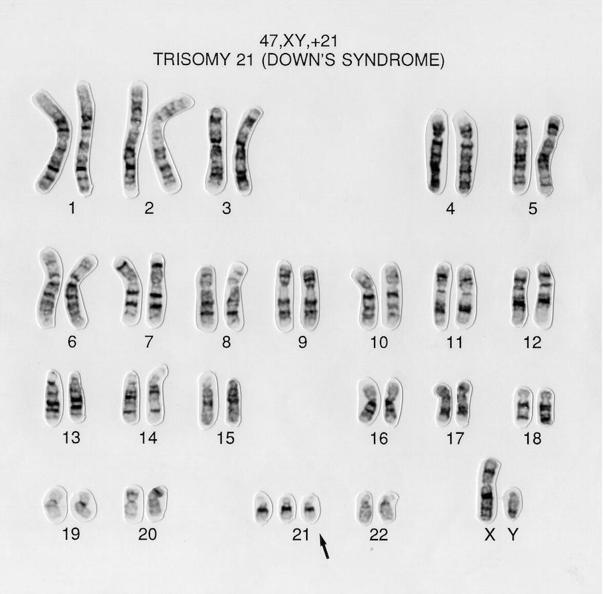
Why are some chromosomal abnormalities worse than others?
February 15, 2007

- Related Topics:
- Trisomy/Aneuploidy,
- Chromosomes,
- X inactivation
A high school teacher from Florida asks:
"Why are some chromosomal abnormalities more devastating than others? For example: Trisomy 13 versus XYY. I figure it has to do something with the genes located on those chromosomes but what genes on those chromosomes make it so devastating to have extra copies?"
You're definitely on the right track. It isn't the chromosome but the genes on the chromosome that matter. Some genes on the extra chromosome will be more harmful than others. But for the most part, we don't know which are the harmful genes.
Having an extra copy of a chromosome is called a trisomy. We know that many genes are dangerous in extra copies because most trisomies are deadly.1
We also believe that larger chromosomes are more likely to have “harmful” genes, because larger chromosomes have more genes in general.
On the other hand, extra copies of some smaller chromosomes, 21 and Y, are better tolerated. Neither seem to have genes that are automatically deadly when there's an extra copy.
Of course, “tolerated” isn't the same as “has no effect.” An extra Y chromosome may make a person taller or more aggressive.
And you've probably heard of, or even know someone with, the disease in which people have an extra copy chromosome 21–Down syndrome, or trisomy 21.
But size isn't everything. For example, chromosome 22 is one of the smallest chromosomes, and yet having an extra copy is deadly.
So except for chromosome 21 and the X and Y chromosomes, every chromosome has at least one gene that is devastating when there are three or more copies.
But why does having extra genes and extra chromosomes matter?
Because our bodies are fine tuned machines that can only function properly with exactly the right amount of genes. To understand why this is, let's go into a bit of detail about genes and chromosomes.

Genes and Chromosomes
We humans have 23 chromosomes and, except for the X and Y chromosomes in men, we have two copies of each one of them (for a total of 46). We get one copy from each of our parents.
Chromosomes are made up of your DNA, your body's instruction book. DNA has directions for your hair color, your eye color, your height, nearly everything!
Genes are also on chromosomes. The genes are like chapters in the DNA instruction book. These instructions are for how to make proteins.
Imagine a book of instructions for how to make a car. There needs to be a chapter on how to make the wheels, a chapter on the engine, the seats, etc.
Each gene is one of these chapters. Genes carry all the instructions for each individual part of the car — you.
The proteins are the physical product of each gene: the wheels, the engine, the seats, etc. In order for the car to work correctly, all the parts need to be made in the right amounts.
Let's get back to our question: why do extra genes make a difference? Well, imagine a car with an extra wheel but no brakes. You would crash!
There are genes like this too. For example, the VEGF gene is important for blood vessel development. An extra copy of VEGF is lethal.2
But not every part of the car is important to how the car works. An extra cup holder wouldn't be a big deal. Or an extra seat belt.
Again, we are the same way. We can tolerate an extra copy of the Y chromosome and chromosome 21 because they don't have any genes that are deadly with an extra copy. And as we explained earlier, other chromosomes are deadly because they all have at least one gene that is deadly in three copies.

The X chromosome
The exception to all this is the X chromosome. Since the X chromosome is large, we would expect an extra copy to be deadly. But this isn't the case. Why not?
This is because the extra X gets turned off, in a process called X inactivation. This happens only to the X chromosome, and not chromosome 1, 2, 3, 21, or any other chromosome.
Why can only the X be inactivated? To make up for the fact that women have more X chromosomes than men. Women have two X chromosomes, while men have one X chromosome and one Y chromosome. This poses a problem–if the number of genes you have has to be just right, how do we get away with half the population having twice as many X chromosome genes as the other?
X inactivation is like the mute button on your TV. When the TV is muted you can still see the picture, but can't hear the sound. When the X is inactivated, it is still in each cell. The body still "sees" that the muted X is there, but can't "hear" the genes on the muted X.
This muting system is very general and works in both men and women. All extra X chromosomes are muted, so each cell only has one “active” X chromosome.
So if you are a woman and have three X chromosomes, two of your chromosomes are muted. If you are a man and have two X chromosomes and one Y chromosome, one of your X chromosomes is muted.
But inactivation isn't perfect. Women who are XXX (called Triple X syndrome) and men who are XXY (called Klinefelter's Syndrome) have symptoms, and may be taller or have disproportionately long arms and legs.
So that's why some chromosomal abnormalities are more devastating than others. You're right that the genes on the extra chromosome are important.
But because we don't know which genes are the deadly ones, we use chromosome size to predict how bad a chromosome abnormality will be. Except for the X chromosome, that is.

Author: Amy Radermacher
When this answer was published in 2007, Amy was a Ph.D. candidate in the Department of Immunology, studying the development of the immune system in Jerry Crabtree’s laboratory. Amy wrote this answer while participating in theStanford at The Tech program.
 Skip Navigation
Skip Navigation
